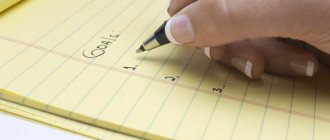The ability to write beautifully is considered a real art, for which a separate term was even created - “calligraphy”. But to achieve success in penmanship, it is not at all necessary to have special talents. All you have to do is be patient and learn a few simple penmanship lessons. In this article we will tell you how to learn to write beautifully and provide step-by-step instructions for improving your handwriting.
Reasons for ugly handwriting
Physiologists identify 4 factors that influence the formation of individual graphic technology:
- anatomical features - structure of the hand, mobility of the joints of the hand;
- visual functions – visual acuity, ability to focus, presence of aberrations;
- neuropsychological processes – development of memory and attention, perseverance;
- working conditions - methods of teaching writing, lighting level, ergonomics of the workplace.
There are also pathological causes of changes in handwriting associated with mental disorders, hearing, vision, and thinking disorders. But this is the responsibility of pathophysiologists - we will consider basic factors that can be easily corrected and help improve the writing style of an adult.
Important! It is not so much the musculoskeletal system that is responsible for the quality of handwriting, but the brain and the coordinated work of all departments responsible for graphic functions.
Select a convenient paper position
As children, we were taught to place paper vertically on the table. If this position is comfortable for you, great! If not, feel free to experiment with different options. Convenient paper placement helps improve handwriting!
For right-handers, the normal position is vertical, but not for me. I have always found it easier to write (especially handwritten texts) by placing a piece of paper horizontally. I'm not kidding, you can see this by watching this short video.
Everyone determines for themselves the best placement of the paper. Try different options and choose the most convenient one. For right-handers, it's best to start with a vertical position and turn the paper to the left until you find your position. Left-handers can do the same, but turning the paper to the right.
Is it difficult for an adult to change handwriting?
Children develop their writing style in elementary school, and by the 6th-7th grade it becomes automatic. However, studies have shown that even after adulthood, the style of writing is constantly changing, and handwriting is finally formed only by the age of 25-30. So if you are in this age group, you have a good chance of learning how to write accurately without putting in a lot of effort.
After 30 years, it is possible to change your handwriting, but it is more difficult.
It will be more difficult for people over 30 years old - at this age a person has already developed a stable manner of writing lines, pressing the pen, tilting letters, spacing between lines and words. Changing the shape and size of graphic elements and tilt features will not be easy, but with due persistence and motivation, a good result is guaranteed.
Lack of leadership
Developing legible writing skills requires proper guidance and support from teachers and parents. Children need to be taught to write correctly and legibly in the classroom and at home. Unfortunately, in this age of technology, this skill is often considered unimportant and neglected. Often teachers and parents are not trained to teach children legible writing skills and therefore cannot guide them properly. As a result, children develop poor grip and poor writing style, resulting in poor handwriting.
How long does it take to change your writing style?
The rate of change will depend on three factors:
- final goal;
- teaching methods;
- pure practice time.
If you are faced with the task of radically changing your writing style, do not expect quick results. It will take 2-3 months to get used to writing numbers and letters in a new way, forming the individual beauty of handwriting.
Daily exercise is important: even for 5 minutes, but every day.
If a small correction is required, the first successes can be noticed after 3-4 weeks, but only if the training method is chosen correctly. On average, teachers provide the following data: by studying for 8 hours daily, the first results can be seen within a month.
A little history
Today, writing is taught in schools at the age of 6-7 years. But in the 17th century, calligraphy was taught even before children began to master reading. The students mechanically copied first letters, then syllables, words, and then even sentences. However, despite the fact that the exercises took more than one month, their effectiveness was minimal. Over time, new techniques for improving handwriting appeared. The result was noticeable when the letter became special. That is, soon learning to write was combined with learning to read. How to correct handwriting for an adult? Exercises, exercises and more exercises.
Preparatory steps
In an effort to acquire beautiful handwriting and learn how to write correctly with a pen, many immediately begin to practice. And they make a fatal mistake by skipping the preparatory stage, which helps to build motivation, evaluate the current features of writing, slowly organize a workplace and purchase high-quality office supplies.
Determining the Purpose of Handwriting Change
Find the reason why you want to adjust your writing style:
- creating attractive inscriptions on postcards, crafts and handmade products;
- giving the handwriting confidence and a touch of “authority”;
- the desire to write legibly so that the text is easier for others and oneself to recognize;
- desire for change for aesthetic reasons.
The era of computerization has weaned us from using writing instruments. Therefore, a person who can write beautifully by hand becomes a valuable specialist.
Assessing current handwriting
Take a notebook sheet and write a short text - it should take 2-3 paragraphs. Write at your usual speed and in a manner characteristic of yourself, do not write out every letter, otherwise an objective assessment will not work. At the end of the work, analyze all the shortcomings, highlighting specific points:
- style of letters - whether you write in printed or capital letters, or maybe use a mixed style;
- height of letters - ideally, they should all be the same height and not be out of order;
- the shape of the letters - angular, too round or elongated impair handwriting;
- tilt – a slight tilt to the right side is considered normal;
- pressure - the pen should glide easily over the paper, creating uniform pressure and without leaving dents on the sheet.
Evaluate the “hooks” that you use to write the letters “i”, “m”, “p”, “l”. They should not merge with each other, impairing the recognition of written words.
Finding a role model
You can look for inspiration on the Internet, in school notebooks, manuals on the basics of calligraphy, etc. Choose the example that you like best - it could be neat, even handwriting, like a schoolboy’s, or elaborate with spectacular curls. Or maybe you like the way celebrities write or want to become the owner of a unique handwriting that slants to the left?
A role model should inspire and motivate you to change.
You can print out the examples you like and put them on your desktop in front of your eyes. This way you can quickly fix a visual image in your memory and copy the details automatically.
Performing hand exercises
The basis of good handwriting is developed fine motor skills. Essentially, these are coordinated movements of the phalanges and joints, allowing you to control actions, confidently hold a pen and draw shaped elements on paper. If you see letters jumping around the line, or appear crooked or angular, try working on your motor skills.
The simplest training is “air” writing, which we were taught in elementary school. Holding the pen with your fingers, bend your elbow at an angle of 70-80° and begin writing out phrases. Carefully move the pen through the air, carefully working out each letter. Take 5 minutes for the exercise and perform it daily - morning, afternoon and evening.
Correct grip
The pen should be held with three fingers of the right hand. Place the accessory between your thumb and index finger, rest it on the left side of the middle finger - this is what the correct grip looks like. The upper part of the handle should rest on the hand at the base of the thumb, while moving away from the tip of the handle at a distance of ⅓ of the length.
When writing, your palm should rest with its edge just above the wrist. Rest your ring and little fingers on a piece of paper - try several positions to find the one that is most comfortable for you.
Important! Do not grip the pen too tightly or raise your wrist too high - this causes excessive tension in the hand and impairs your handwriting.
High-quality office
There are no strict requirements for stationery, but it is important that the pen is comfortable to hold in your hand. Use classic models - a very thick or very thin pen will not be able to write neat letters. The thickness of the rod should also be medium - with thick lines the letters will turn out awkward.
Working with the office should be fun.
But you should choose the paper carefully - office sheets with a smooth surface or school notebooks are best suited. Avoid glossy paper - the pen will glide too quickly on it, and you will not be able to clearly control the movements.
Correct seating at the table
The following rules will help you achieve the correct seating position at your workplace:
- Sit upright, leaning your torso close to the back of the chair.
- Do not lean on the tabletop - maintain distance between the table and your chest.
- Elbows should rest on the tabletop, with the elbow joint bent at an angle of 90°.
- Maintain a right angle between your body and your hips when planting your feet. In relation to the floor, the thighs should be horizontal and the shins vertical.
- Place your feet firmly on the floor - they should touch the entire surface of the floor.
- Adjust the height of the chair and table to suit your height. The seat should be strictly under the knees, and the tabletop should be at navel level.
Using a lined sheet
The lined sheet is a ready-made template that will be useful to anyone who wants to improve their handwriting at home. It will help control the height of letters and achieve even lines. Lined sheets are sold as school workbooks, but you can create your own template in Word and print it out.
Important! If, in addition to the height of the letters and the direction of the lines, you need to adjust the slant when writing, choose notebooks with an oblique line.
Use a comfortable handle
Convenient just for you! You may have to search for a pen that suits your needs. In terms of line thickness and ergonomics, I liked the Pilot G2 05, black. The pen has good sensitivity - you don't need to press hard when writing.
There are a lot of pens out there and I encourage you to shop around and try a few options before choosing yours. It doesn’t matter whether you prefer gel, fountain or ballpoint pens - any that are convenient for you will do.
Body exercise
As we mentioned above, physical fitness and the condition of the musculoskeletal system directly affect the characteristics of writing. Take time to exercise daily to improve fine motor skills and keep your muscles toned.
Development of fine motor skills of hands
Take advantage of 6 methods:
- Take up drawing or doodling - coloring patterns with colored pencils.
- Master the ten-finger typing method on a computer keyboard, or simply type more often using as many fingers as possible.
- Do finger exercises, working the small and large joints of the hand.
- Take up handicrafts, modeling, beading.
- Learn to write with your left hand (for right-handed people) or your right hand (for left-handed people).
- Master the use of objects with your non-dominant hand - hammering nails, sweeping the floor, holding cutlery, etc.
Training the muscles of the back and shoulder girdle
For training, simple exercises that can be performed at home are suitable. Well strengthens the muscles of the shoulder girdle and back:
- pull-ups on the horizontal bar;
- pushups;
- circular movements with outstretched arms;
- back extension on a gymnastic ball;
- lifting opposite arms and legs in a lying position;
- bending in a standing position with fingers touching the floor, etc.
Development of spatial perception
Such a favorite pastime as putting together puzzles helps to develop visual-motor integration. Choose more difficult tasks that you will have to work on for more than one day.
Putting together puzzles improves spatial perception.
Another interesting exercise is to virtually change an object. Imagine any physical object and try to mentally change its shape, size, color, combine it with other parts or add decor.
Joint hypermobility syndrome
Joint hypermobility syndrome is a condition in which the joints become hyperflexible and may move beyond normal limits. The joints of such people have weak support, and therefore more effort is required to maintain the position. This can cause them muscle fatigue and pain, as well as poor coordination and balance. This pain can cause handwriting problems in those affected (6) . Children with this condition may also have trouble gripping a pencil/pen, which affects their handwriting.
Note. If your child has any of the conditions listed above, help him learn at his own pace and don't compare his progress to other children.
Ways to improve handwriting
We are done with preparation methods. Now let’s move on to specific techniques that will help you learn to write accurately in a notebook and on blank sheets of paper.
Using copybooks
Sometimes, in order to move on, it is necessary to return to the roots - we are talking about the copybooks by which each of us learned to write in elementary school. The copybooks contain reference examples of the style of each letter and number.
The recipes will be useful not only for kids, but also for adults.
By repeatedly copying details from a pattern, you will eventually break old habits of sloppy writing and be able to develop new skills. Work diligently, like an exemplary student, and you will not only be able to write beautifully, but also achieve calligraphic handwriting.
Advice! Use squared notebooks for training. Transfer the text to the sheet, trying to place each letter in a separate cell, without protruding beyond its boundaries.
Writing letters in the air
Return to the air letter training that we described just above. This is not only a great way to practice fine motor skills, but also an important part of acquiring beautiful handwriting.
Don’t rush to write entire words at once - write out the letter step by step, carefully drawing each element in the air. When the result seems satisfactory to you, put it on paper - write the studied letter with a pen and try to combine it with others into whole words.
Start with block letters
Another interesting way to write penmanship is to learn how to carefully print block letters on a sheet of paper in a square. A sample that will serve as a reference for you will come in handy here. Look for spectacular examples and try to repeat each letter in printable format.
Try writing the sentence “Have some more of these soft, fresh French rolls and then have some tea.” It contains the entire Russian alphabet, so after writing you can evaluate your handwriting and see your “weak” spots.
Using an ink pen
Fountain pens give new sensations when writing, allowing you to develop an individual style of calligraphy. Practice shows that when using an ink pen, we draw out each text element more diligently. The handwriting turns out clear, neat and even stylish - why not try it?
Class time and importance of calligraphy
You can improve your handwriting at any age. The main thing is to devote the necessary time to work. Every day you need to train for at least half an hour. If you do it once a week, it won't do anything. It is unlikely that you will achieve your goal in lectures or school lessons. It’s best to do workouts at home, when you don’t need to rush anywhere and you can maintain a comfortable pace.
Having completed the work in a notebook with oblique lines, you need to purchase the most beautiful notebook and write down your favorite quotes, sayings, etc. in it. You can keep a personal diary. Gymnastics for the fingers will also bring certain benefits. Systematic training will definitely help you achieve results.
People of old times are firmly convinced that handwriting is the calling card of a person. That is why, in their opinion, a person should be able to write letters beautifully and legibly . However, it is worth thinking about how often modern people are faced with the need to write something. If previously there were many professions where it was necessary to write letters beautifully, now documents are issued in printed form. You can even sign a postcard using the printer using your favorite decorative font. Nowadays, the beauty of writing is no longer so important and, perhaps, it is not worth tormenting children, trying to get them to have perfect handwriting. On the other hand, many of us have encountered a situation where the visa printed on a document is deciphered by all office employees.
Step-by-step instructions for adults
When the basic techniques for improving handwriting have been mastered, you can proceed to the main stage - it includes 4 important steps.
Choosing a role model
Yes, there are certain standards for writing letters. But this doesn't mean you can't add a personal touch to your new handwriting. When you learn to write all the letter elements correctly, create your own graphic technique. These can be interesting curls, playful ponytails, underlines, or a special configuration of letters.
When handwriting is brought to automaticity, even fancy letters will look organic, and the written text will be easy to read.
Daily spelling practice
To achieve an ideal result, you will have to allocate enough time to repeat the letters many times. Allocate a separate sheet for each element of the alphabet, and if this is not enough, do multiple approaches.
Write one letter dozens of times.
Changing handwriting is a slow process; the hand must get used to non-standard movements. The longer you practice, the better the new style will become embedded in your visual memory and subconscious.
Connecting letters into words
It is not enough to learn to diligently write individual letters - you need to be able to beautifully put them into words and sentences. Connecting lines should be smooth to blend seamlessly with adjacent symbols. This skill will also have to be trained by diligently creating notebooks of texts.
Italics is considered the standard for the correct combination of elements in words. Try copying text written in cursive font to understand the principles of creating connectives. The hand should be relaxed - do not forget to follow the slope of the line and close all the spaces between the letters.
Bringing it to automation
Achieving success in penmanship will not be possible without intensive training. This is the only way you can bring the acquired skill to automaticity and consolidate your new handwriting on a subconscious level. Set aside time every day to write down 2-3 pages of dictation, and if there is no one to dictate the text, copy the sentences from the sample. Try to gradually increase the speed of your work - and if even in intensive mode the text remains just as legible and neat, you can safely congratulate yourself on your victory.
You can learn to write beautifully at any age with the proper persistence and good motivation. Assess your handwriting weaknesses, find a role model, and buy comfortable writing utensils. Love the process of penmanship itself, be patient - and excellent results will not keep you waiting!
What to do before training?
Before you start training, you need to do an analysis of your handwriting so that you know what to work on. To do this, you should write several sentences and evaluate them according to the following parameters: the distance between words, the distance between letters, their size, slope, pressure, evenness of lines, clarity of drawn lines, writing style. Only after you have sensibly assessed the features of your existing handwriting, when you have determined what exactly you don’t like, can you begin the above exercises.
If you haven’t yet decided what style you want to train, you can analyze other people’s handwriting and study ready-made fonts. Try writing letters imitating these fonts. You can also experiment and combine some elements with your handwriting. Find that perfect option and train it using a variety of exercises. Correcting an adult's handwriting is much easier than it seems.
Abbreviations system
Any schoolchild knows about the existence of generally accepted abbreviations; students are also unlikely to think of writing down words like “so on”, “like that” in full. Everyone knows the principles of reducing units of measurement of volume, length, speed and other quantities. However, for those who are interested in learning how to write quickly with a pen, this is not enough.
Reading scientific literature helps you master the art of shortening text. For example, the name of the subject in articles is used only at the beginning, then only the first letter with a dot is placed. A student can also invent a personal system of abbreviations by devoting some time to this. How to learn to write quickly with a pen? For example, you can remove all letters from a word except the initial and final ones, or use only the first letters.
Of course, entries made using abbreviations must be understandable. If it takes a lot of time to decipher them, it is simply not practical to continue using this method.
We follow simple rules
Following some rules will help you achieve excellent results in learning to write:
- Furniture for writing should be selected appropriately. This means a comfortable backrest for the chair and a table that matches your height. It is unlikely that the training process will be successful if a person decides to sit in bed or in a chair, using his own knees as a stand for a notebook.
- When thinking about how to learn to write quickly and beautifully, you need to pay attention to the position of your body. The position chosen is, first of all, comfortable. The back should be straight, let the back of the chair serve as support for it. After sitting down at the table, you need to check the position of your knees. Ninety degrees - at this angle let them be bent.
- Pay attention to the sheet of paper. It would be more correct if it lies slightly to the right of the human body.
A few words about presentations
The system of abbreviations does not come to the aid of the student in all situations. How to learn to quickly write a summary without breaking the rules of grammar? Here, a good memory will come to the aid of the student first of all, therefore, it must be constantly trained. To do this, you can memorize poems, retell books you’ve read aloud, or better yet, write down their summary.
The draft is used at the stage when the student listens to the text on which the presentation is written. It is necessary to record on paper the outline of the story, main thoughts, complex words and expressions. The points do not have to be detailed; they are only required to highlight the main issues. To avoid wasting valuable time thinking about how to spell this or that word correctly, which punctuation mark to choose in this or that case, it is necessary to learn the rules of grammar and punctuation.
How to learn to write quickly and beautifully without mistakes
While observing the beauty of letters, we must not forget about basic literacy. If you have difficulties with the last point, you can:
- Spend time reading aloud periodically.
- Memorizing poems.
- Performing special exercises, such as daily copying of book texts onto paper.
- Carefully read the written text. Moreover, you can do this more than once.
- To test the acquired knowledge, it would be nice to conduct control dictations.











